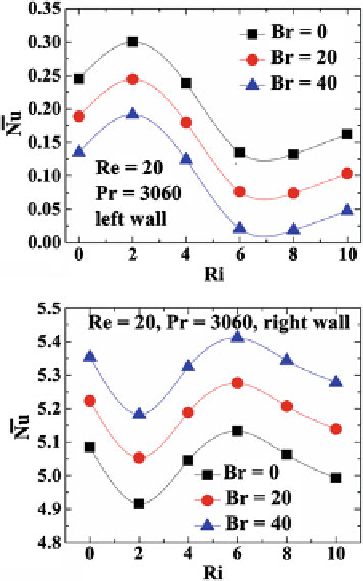Environmental Engineering Reference
In-Depth Information
4 Results
Figure
2
shows the predicted overall Nusselt number at both walls for
Re
=
20,
Pr
1 for several values of the Brinkman and Richardson numbers.
We note that due of the imposed boundary conditions, small values of the mean
Nusselt number are obtained at the left wall, while enhanced heat transfer occurs at
the right wall. In the absence of buoyancy (
Ri
=
3,060 and
B
=
0), the overall heat transfer at the left
wall reduces when the Brinkman number increases, while the opposite is observed
at the right wall. This behavior is explained by the increase of the energy generated
by viscous dissipation, which in turn yields a higher fluid temperature. A similar
trend is observed for all values of the buoyancy parameter at the left and right walls,
respectively.
For aRichardson number of
Ri
=
2 and for all the computed values of theBrinkman
number, heat transfer at the left wall is enhanced because of an increase in the size
of the recirculation zone that appears at the lower left corner of the enclosure. In
addition, a recirculation bubble at the lower right corner with twice the size of the
left vortex increases the temperature close to the right wall, while reducing its cor-
responding Nusselt number. This effect occurs because of the internal forcing that
the system undergoes due to viscous dissipation and variable viscosity effects. For a
=
Fig. 2
Overall Nusselt
number at the
left
and
right
wall
for
Re
=
20,
Pr
=
3,060
and
B
1 for several values
of the
Br
and
Ri
, respectively
=

Search WWH ::

Custom Search